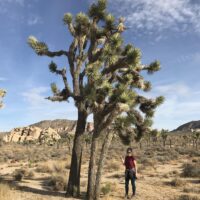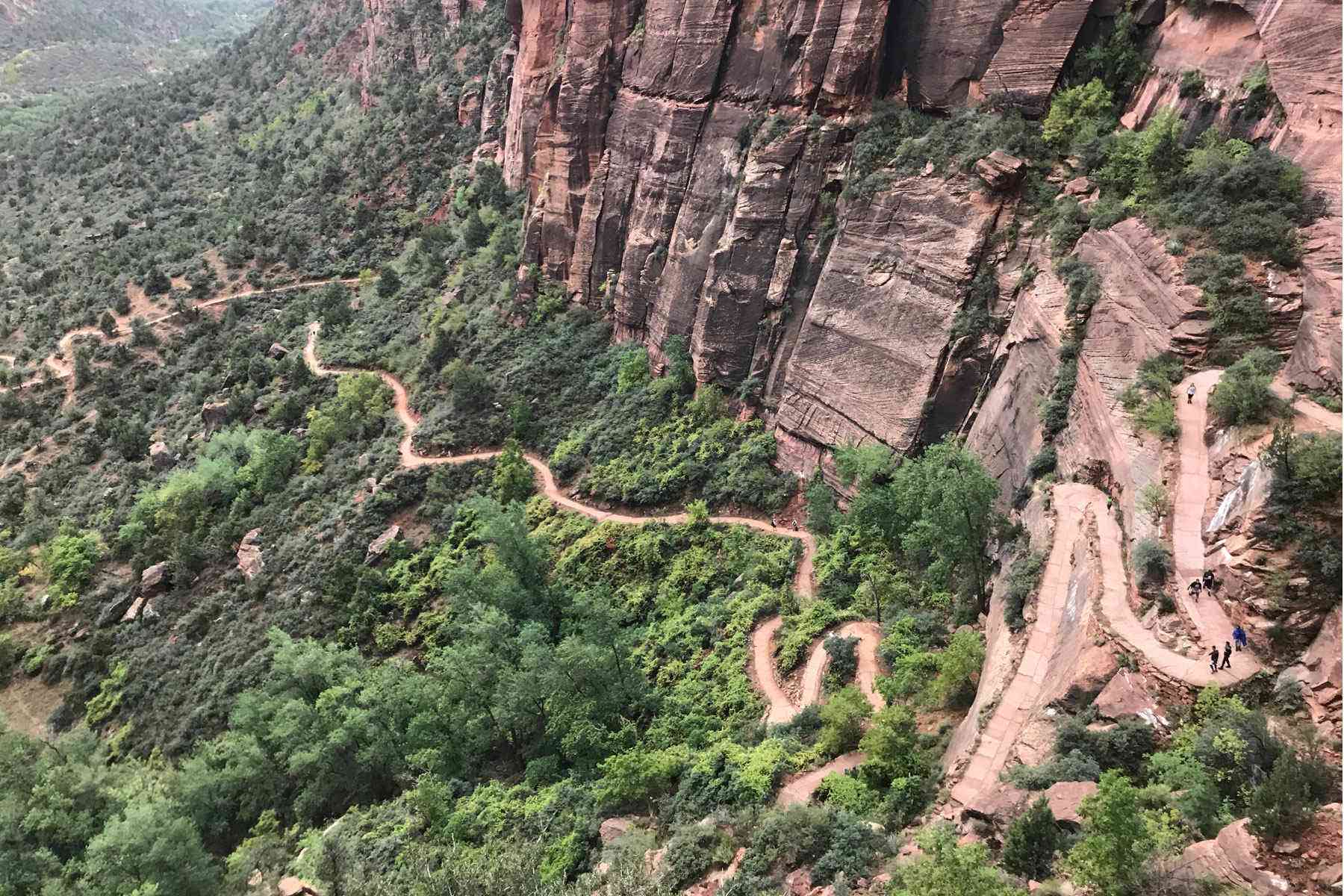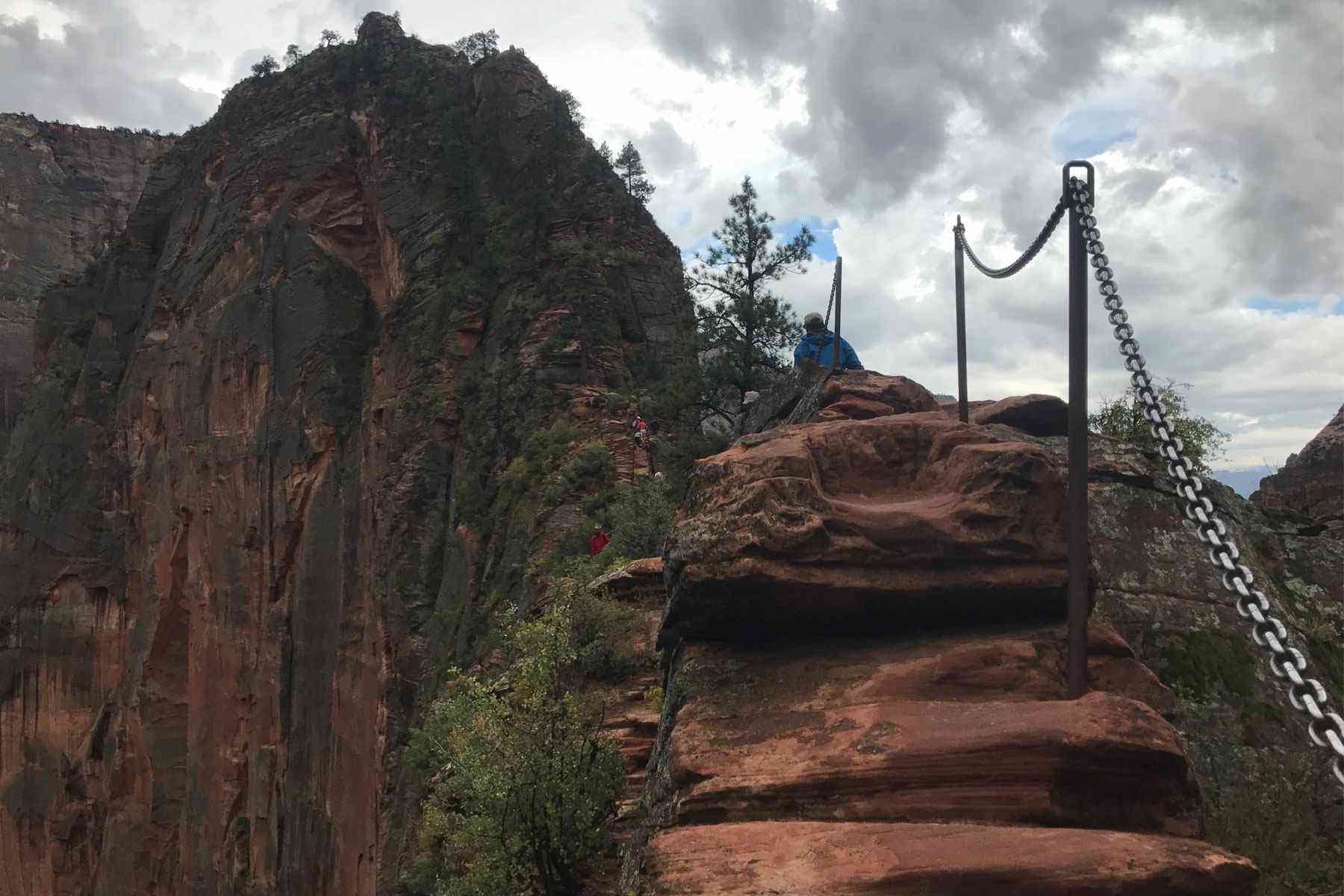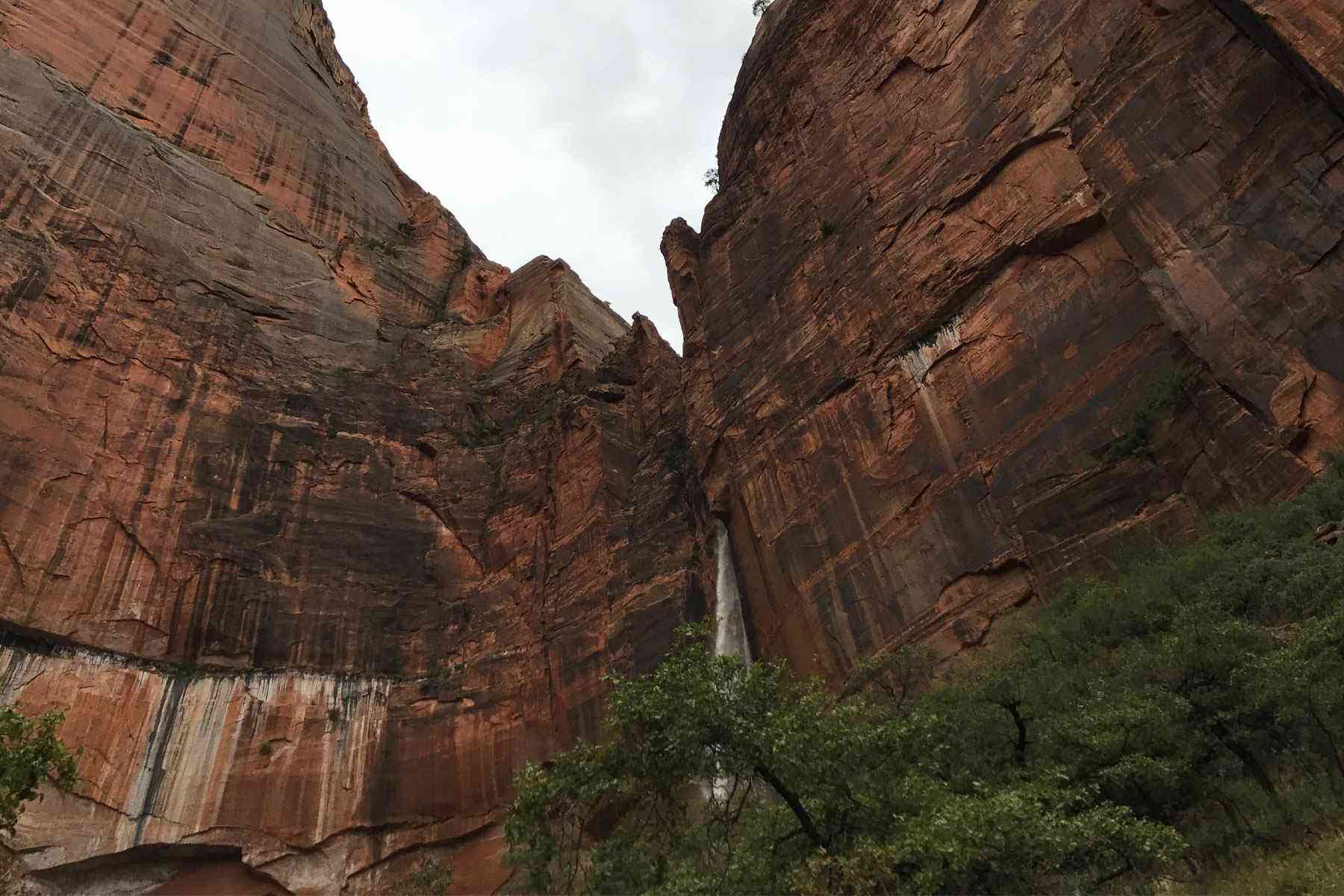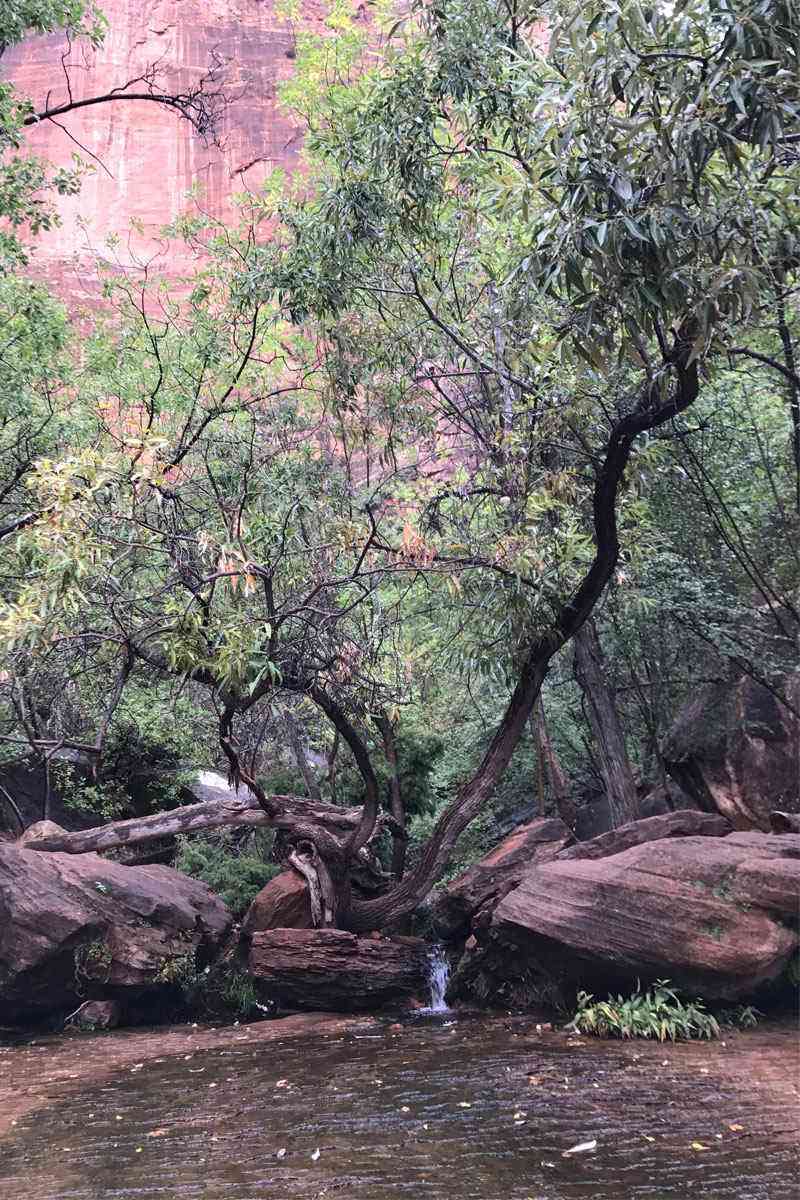So beautiful, yet so deadly.
The juxtaposition of rainbowed red rock against endless blue sky, crumbling desert climbing up to tumbling forest, endless mesa bluffs hanging over narrow canyon wedges—the visual contrasts of Southwest Utah’s Zion National Park bend the mind to near incomprehension. The only way to appreciate the dissonance of these landforms is to strap on a helmet and succumb to the rappel drop, squeeze through the slot canyons, rush under erupting waterfalls, and keep climbing to the stunning views. Only then can you realize the many faces of Zion.
A brilliantly dry and sunny day of canyoneering led us up from the drylands, hiking through rattlesnake territory to the boulders and ridges of sandstone, thousands of feet above the ground. What goes up must come down, and while we’re reciting maxims, let’s take the path of least resistance. Suited up in a harness and with only basic instructions from the guide (“follow gravity”), I locked my carabiner into place and leaned back in a trust fall with only rock and rope.
We would already be in Heaven if we died, I supposed.
Canyoneering, climbing, and rappelling are beloved sports in Zion National Park, and some of the best ways to experience the claustrophobia of the slot canyon and the vertigo of the sheer cliffs towering above you. Rappelling is the “easiest” of this type of technical climbing in that a climber is only required to slide down the face of a mountain in a harness and on a simple system of rope “pulleys.” Scrambling is a vigorous type of hiking that involves the use of hands—not necessarily the complexity of climbing with ropes, but problem-solving is utilized to find the best route up and down the mountain. My fellow adventurers couldn’t help but reference 127 Hours, the James Franco movie based on the true story of a mountaineer who had to saw his arm off to free himself from a fallen boulder. We might as well have been on that movie set. As we regrouped on a plateau about halfway down the mountain, we observed a moment of silence for the land. Zion, which means ‘place of peace,’ truly lives up to its name. But the zen we felt in the moment was couched with vigilance: this land can and does attack without provocation.
Recommended Fodor’s Video

After hours of scrambling, squeezing, and problem-solving our way through slot canyons, we headed safely back to the mesa top, with views as tall as they are wide. The weather compounds the multifaceted nature of this land—the sky is no exception in the area’s potential about-face. At that point, the cloudy wisps were merely whipping past, but the pressure was falling fast. The evening gave way to lightning strikes over the cliffs and mountains that surround the parklands of Zion National Park and its community of permanent residents in Springdale, Utah. Zion’s number one rule for safety? Beware of flash-flooding, emphasis on the flash.

By sunrise the next day, it was pitch black and pouring. Lightning flashed, illuminating the massive towers and bluffs that comprise the Court of Patriarchs, sandstone peaks named by the Mormons for Jacob, Issac, and Abraham, and striking the air in every direction. The storms moved west to east in rapid succession, and with the knowledge that flash floods can be deadly for those who play fast and loose with the weather, our adventurous squad cautiously, optimistically headed toward the trailhead of The Narrows, perhaps the most famous hike in the park that involves wading (and even swimming) through the Virgin River as it carves the canyon floor.
The dizzying drop-offs on either side of the Angel’s Landing ridge are nothing compared to the sheer ledges where hikers must pull themselves along heavy chains bolted to the cliffside.
There would be no forging the Narrows this day, not even with our outfitted gear: heavy-duty canyoneering boots, Neoprene Socks, walking sticks, and dry bags to keep us as sturdy and dry as possible. Instead, we heard the thunder roll through and bounce around the canyon walls; as the skies opened up to rain, we watched from the valley floor as sudden waterfalls—waterfalls that did not exist just moments before—erupted over cliff edges. It was easy to imagine being swept up in fast moving waters, losing footing on slippery edges, or becoming a rod for the electricity pulsing through the atmosphere. We would already be in Heaven if we died, I supposed. We must head for higher, drier ground.
Zion Park comprises of four life zones (essentially, characteristics of life at the same altitude or latitude) that a hiker can summit in just one trip: from desert (very little rain) to riparian (living against a stream or waterway), then woodland (low-density forests with lots of sun) and coniferous forest (cone-bearing trees or shrubs), the earth’s biomes change with the stark elevation increase of three to eight thousand feet above sea level. The effect is dizzying.
The guides divided us into those who want to die and those who don’t.
The guides divided us into those who want to die and those who don’t: some of us would traverse the terrifying ledges of Angel’s Landing, others would race against the flooding of the rapidly rising Emerald Pools.
The dizzying drop-offs on either side of the Angel’s Landing ridge are nothing compared to the sheer ledges where hikers must pull themselves along heavy chains bolted to the cliffside. The reward is mighty—an opportunity to view Zion from a ridge where “only an angel could possibly land” and the bragging rights of scaling the heavenly trail.
Lingering could lead to getting stuck on the wrong side of the flooding.
The Emerald Pool trail offered its own dangers masked in tranquility: tiered, gem-colored pools spilling gently over the cliff’s edges. The rainstorm churned on and off, and the trickles gathered steam. What at first sounded like thunder was actually the loosening of boulders from somewhere above—and then a cascade of water shooting out from the rock, exploding into the pool and sending the floods quickly downstream. Our guide warned us to get a move on; lingering could lead to getting stuck on the wrong side of the flooding.
No matter the trail or weather, the beauty and grandeur of the landscape quiet any nagging fears. Perhaps that is peace experienced at Zion—a sense of something greater than mere mortality and self-preservation. The forced experience of looking out, and up, and beyond, rather than in, brings humans into harmony and even submission to the environment. We enter our natural state and give in to what the world holds for us. Perhaps Zion is neither zen nor menace, but a place to project our joy and our fear, and the only way to discover what it holds for us is to dive in with open eyes and hearts.
If You Go/Where to Stay
Camping: The popular 176-site Watchman Campground is just a quarter-mile from the South Entrance to the park, and offers car camping necessities (fire rings, nearby flush toilets and access to drinking water) and easy access (shuttle service to the park and nearby Springdale) or 18 tent-only sites to really ~get away from it all~.
Glamping: Under Canvas Zion offers all the amenities of a private hotel stay but just steps from hiking trails. Just outside the park, these perma-tents house a King-sized bed; bathroom with shower, sink, and flushing toilet; and a wood stove.
Lodging: If you love the great outdoors but need your nature stay with a soft bed and temperature control, SpringHill Suites Springdale Zion National Park offers you the creature comforts of a lovely hotel smack in the middle of rugged landscapes.




